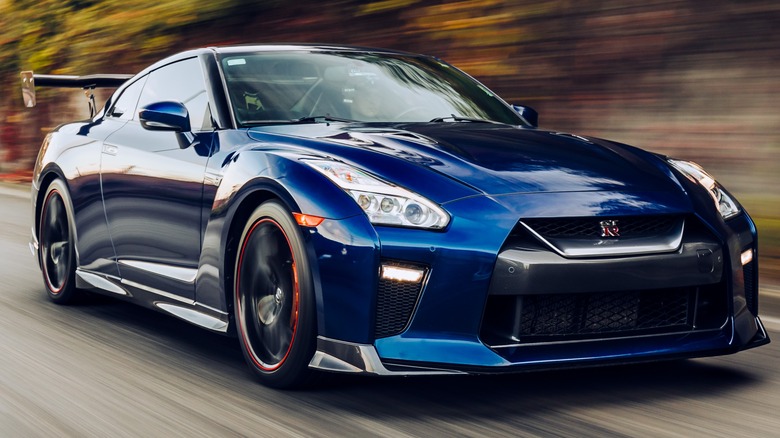
Brandon Woyshnis/Getty Images
All-wheel drive (AWD) sports cars promise the perfect blend of surefooted handling and pulse-pounding performance, making them ideal options for anyone craving an unforgettable driving experience. Once relegated to off-road pickup trucks and SUVs, AWD technology has become increasingly prevalent in the sports car scene. That’s due to the growing demand for all-year performance, especially in regions with unpredictable weather conditions.
Unlike rear-wheel drive (RWD) or front-wheel drive (FWD) counterparts, AWD sports cars boast superior handling and traction in slippery conditions. While platforms like RWD help lower the overall weight of the car, AWD provides better control during aggressive maneuvers or spirited driving on twisty roads. Below, we aim to help you navigate the world of AWD sports cars, delving into a selection of the most captivating alternatives from automakers like BMW M, Mercedes-AMG, Nissan, Porsche, and Audi. We’ll assess their performance specifications, unique features, and how their all-wheel drive systems make them stand out from the crowd.
Audi RS 5 Coupe
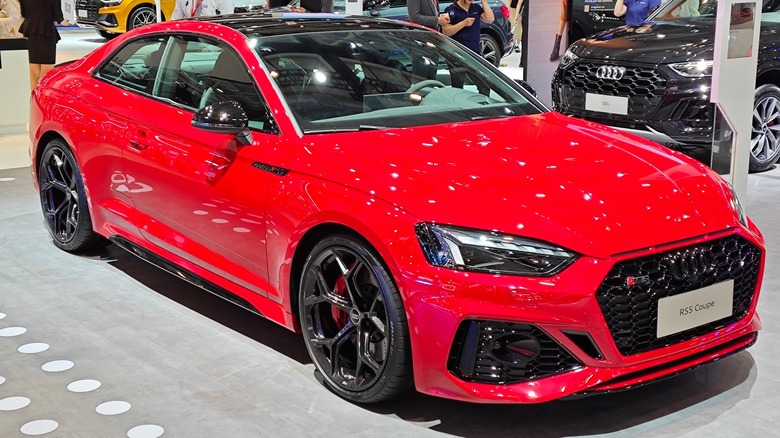
Jack Skeens/Shutterstock
Audi’s RS badge signifies pinnacle performance. Born from the legendary RS 2 Avant co-developed with Porsche, the lineup has had iconic models like the RS 4 Avant and the V10-powered RS 6 Sedan. While the R8 previously reigned supreme, its 2023 farewell marked Audi Sport’s electric push. Today, the RS torch is carried by a range of thrilling vehicles like the RS 5 Coupe. The Audi RS 5 Coupe remains a champion for the driving enthusiast, boasting a 2.9-liter twin-turbocharged V6 with 444 hp and 442 lb-ft of torque. The engine partners with an eight-speed automatic transmission, propelling the RS 5 from 0 to 60 mph in 3.7 seconds and reaching a 174-mph top speed.
Audi’s legendary quattro all-wheel drive system is the cornerstone of RS performance. Honed in the fires of rally racing, the Quattro all-wheel drive system distributes torque to all four wheels based on traction/stability control, steering angle sensors, and yaw sensors. In the RS 5, it takes on a more dynamic character with the rear sport differential. An intelligent system with an overdrive ability to actively distribute power between the rear wheels, especially during aggressive cornering, for exceptional handling and driver confidence.
The result is a flat cornering star, as evidenced in our review of its four-door sibling, the RS 5 Sportback. Audi’s combination of the Quattro all-wheel drive and rear differential enhances predictability and grip, allowing the RS 5’s V6 power to be unleashed with confidence. This winning formula makes the RS 5 a compelling all-season sports car.
Bentley Continental GT
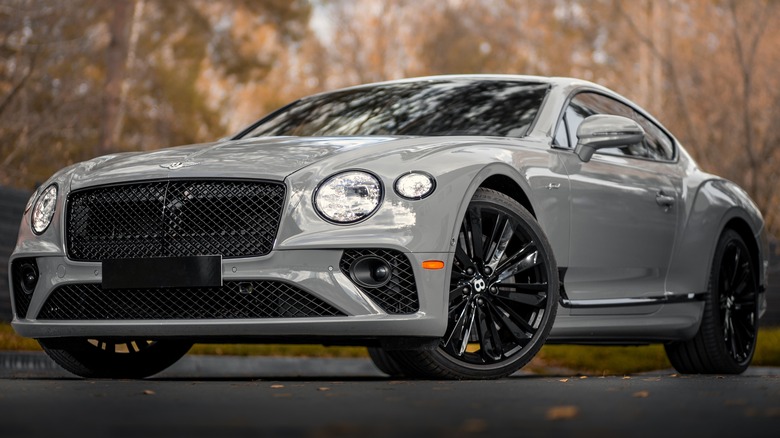
Everyonephoto Studio/Shutterstock
Bentley’s Continental GT debuted in the early 2000s, a head-turning two-door that defied expectations. This grand tourer wasn’t just exquisitely crafted, it was a performance powerhouse. Over two decades later, the Continental GT remains a Bentley mainstay, continuously pushing the boundaries of what a luxury coupe can be. Offered in both coupe and convertible forms (the GT C), the Continental GT competes with luxury titans like the all-electric Rolls-Royce Spectre.
Power comes from two heart-pounding options: a 4.0-liter twin-turbocharged V8 or a hand-built 6.0-liter W12. These engines pair with an eight-speed dual-clutch automatic, helping offer quick gearshifts and smooth acceleration. While both engines have enough power to help the Continental GT achieve a sub-four second 0 to 60 time and a 207-mph top speed, Bentley doesn’t stop at raw power. An active all-wheel drive system, an all-wheel steering system, and an electronically limited-slip differential help keep it planted and inspire driver confidence.
Our time with the Continental GT Speed exemplified why it’s a fascinating luxury sports car. Despite its imposing weight, the Continental GT can hustle thanks to its upgraded talents. Its raw power makes it a straight-line champion, while the AWD system and electronics, like the drive mode-based ESC, help enhance its canyon carving and donut-making capabilities. Bentley’s prodigious carbon ceramic brakes have planet-stopping power, bringing this 5,011-pound sports car to a halt with authority.
BMW M4
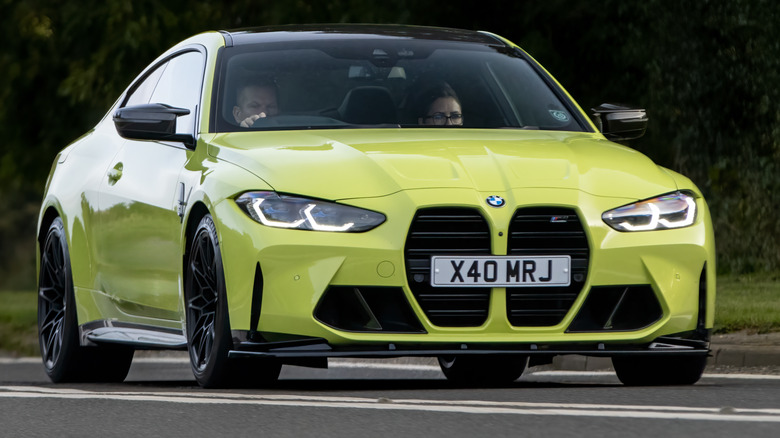
Sue Thatcher/Getty Images
First introduced in 2014 as coupe and convertible versions of the BMW 3 Series, the BMW M4 lineup has grown into a segment of its own. Nowadays, BMW’s 4 Series lineup consists of not only convertible and coupe models but also four-door Gran Coupe models. Since it shares its DNA with the 3 Series sedan, the M4 boasts BMW M’s consistent performance advancements. The M4 has four trims: M4 Coupe, M4 Competition Coupe, M4 Competition xDrive Coupe, and M4 Competition xDrive Convertible. Power comes from a 3.0-liter twin-turbocharged inline-six engine with performance ranging from 473 hp to 543 hp.
As standard, the M4 powers the rear wheels through a six-speed manual or an eight-speed automatic. However, the top xDrive trims get the automatic transmission and BMW M’s xDrive setup, a rear-wheel-biased all-wheel drive system. This intelligent all-wheel drive system uses an electronically controlled multi-clutch in the transfer case, smoothly allocating the engine’s power between the front and rear wheels. It also features a fully variable active M differential at the rear, giving the M4 the signature M feel when powering through corners or accelerating in a straight line.
BMW’s M4 lineup is undeniably quick, but the xDrive models are the quickest, launching from 0 to 60 mph in 3.4 seconds. The M xDrive system offers the best of both worlds: confidence-inspiring all-wheel drive and a dedicated 2WD mode for those seeking a pure, drift-friendly experience. With a weight gain of just 99 pounds, xDrive adds a layer of all-weather capability that enhances the M4’s daily driver credentials without sacrificing its performance DNA.
Chevrolet Corvette
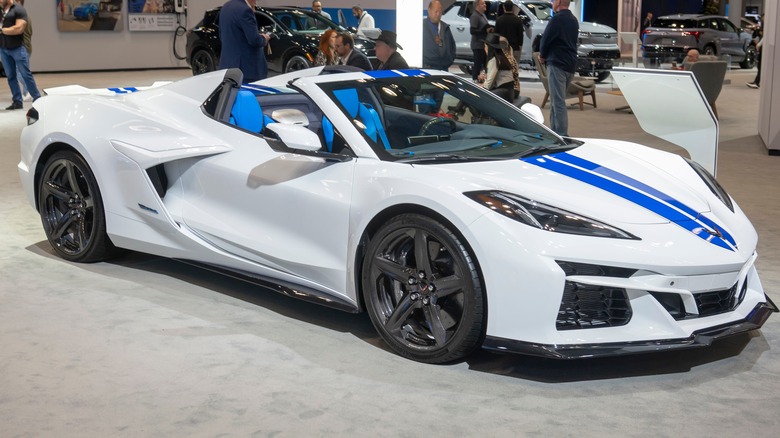
Ron Adar/Shutterstock
Chevrolet introduced its eighth-generation Corvette in Tustin, California, in 2019. This was the brand’s first production mid-engine Corvette, boasting the fastest times of any entry Corvette. Today, the Corvette is available in three configurations: Stingray, Z06, and E-Ray. Like their predecessors, these trims use V8 engines, but the Z06 boasts a mightier 5.5-liter flat-plane crank version.
The E-Ray is the first Corvette to ever feature a hybrid powertrain. It boasts the LT2 V8 engine, similar to that in the Stingray, producing 495 hp and 470 lb-ft of torque. Chevrolet also equips the Corvette E-Ray with a 160 hp electric motor, powering the front axle. Combined, the motor and V8 engine produce 655 hp, helping the E-Ray scamper from 0 to 60 mph in 2.5 seconds and complete the quarter mile in 10.5 seconds.
The addition of an electric motor on the front axle gifts the Chevrolet Corvette E-Ray all-wheel drive capabilities, the first in any Corvette. This eAWD system constantly learns the road surface, quickly adapting to satiate driver needs and traction conditions. While some may notice a hint of torque steer, mastering the drive modes harnesses the power of eAWD, effortlessly hauling the E-Ray out of corners. With innovative technologies and electrifying performance, the E-Ray establishes a new chapter in the Corvette legacy, rivaled only by the likes of the new Porsche 911 hybrid.
Ferrari SF90
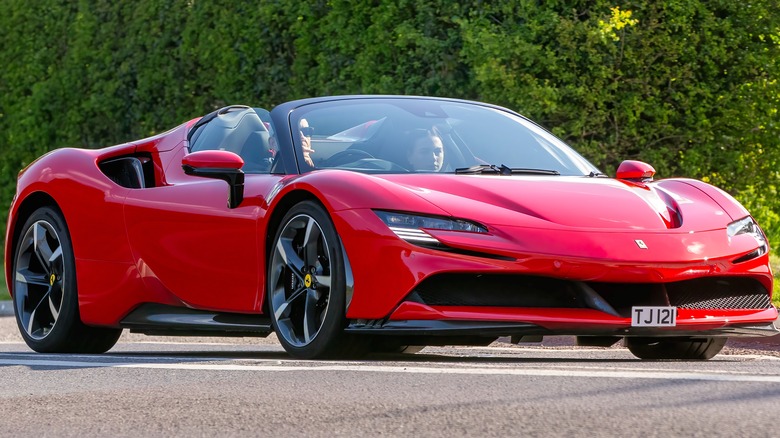
Sue Thatcher/Shutterstock
In 2019, Ferrari introduced the next chapter in its history — a new plug-in hybrid super sports car, the SF90 Stradale. With a staggering 986 hp and 860 pounds of downforce at 155 mph, the SF90 vaulted to the pinnacle of the super sports car echelon. Ditching tradition, Ferrari opted for a twin-turbocharged V8 instead of the customary V12 for its range-topping model. Since then, the SF90 family has expanded to include the open-air Spider variant and the Track-focused XX models in both Stradale and Spider forms.
These models boast a 4.0 twin-turbocharged V8 engine and a trio of electric motors. The base SF90 models produce 986 hp, while the SF90 XX models unlock 30 more ponies to produce 1,016 hp. Two electric motors propel the front axle, while the third, a single F1-style MGUK motor, is nestled between the new eight-speed dual-clutch transmission and the V8. Despite this seemingly complex setup, Ferrari offers four intuitive powertrain modes, making the SF90 surprisingly driver-friendly.
The unique hybrid layout makes the SF90 the first all-wheel drive Ferrari, allowing it to channel all its power to the ground for a blistering 0 to 62 mph run of 2.5 seconds. Its full electric front axle, known as RAC-e, independently controls torque delivered to the front wheels, making spirited driving simpler. It also provides propulsion in electric drive, giving the SF90 Stradale an all-electric range of nine miles. By incorporating F1-derived technology, the SF90 cements its position as a technological marvel and a rare AWD sports car with a direct link to Formula 1’s racing heritage.
Lamborghini Revuelto
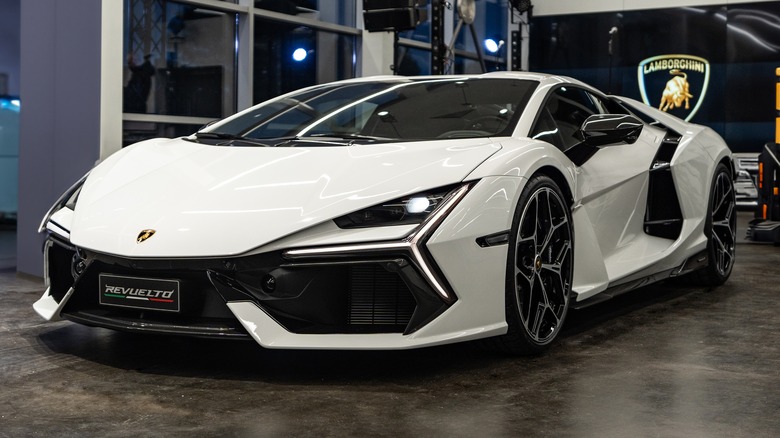
North Monaco/Shutterstock
Lamborghini unveiled the Revuelto, a V12 plug-in hybrid super sports car, in 2023 during its 60th anniversary. This groundbreaking machine rewrites Lamborghini’s script for performance, sportiness, and driving pleasure. It uses a new carbon fiber frame, which ushers in a new era of design, architecture, and aerodynamics. While entirely new, the Revuelto pays homage to Lamborghini’s V12 legacy. First introduced in the 1963 350 GT, the V12 has become synonymous with Lamborghini’s untamed spirit.
The Aventador successor combines a 6.5-liter V12 with three electric motors to produce 1,001 hp. This powertrain helps the Revuelto not only reduce emissions but also maximize performance. The result is a 2.5-second 0 to 62 mph sprint and a top speed exceeding 217 mph. The hybrid architecture cleverly utilizes two of the electric motors to power the front wheels, while the engine powers the rear wheels. This results in exceptional all-wheel drive traction.
Beyond raw power, we found that the Revuelto’s motors offered exceptional torque in our first drive, enabling explosive acceleration out of corners and an immediate throttle response akin to an EV. However, the hybrid’s benefits extend beyond initial power. It introduces torque vectoring to the front axle, optimizing handling and energy recovery during braking. This system distributes torque optimally to each wheel, enabling the Revuelto to corner with remarkable precision. Furthermore, the system works in conjunction with the four-wheel steering system, further enhancing agility and stability in high-speed cornering.
Mercedes-AMG SL 63
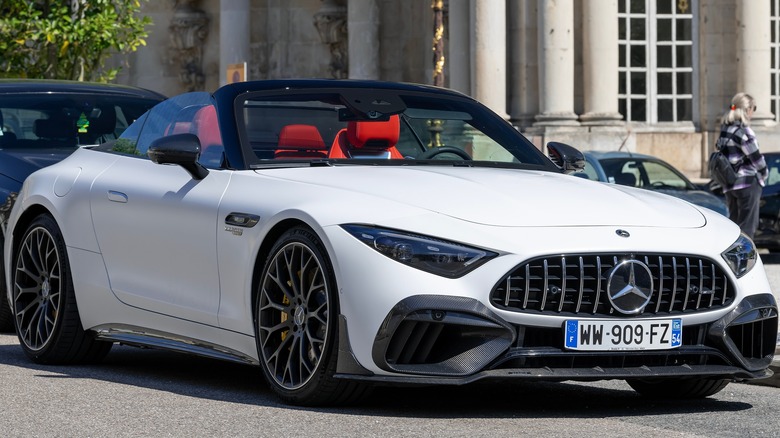
Alexandre Prevot/Shutterstock
In 2021, Mercedes-AMG unleashed a new generation SL, a luxurious roadster reborn with cutting-edge tech, a wider powertrain palette, and the brand’s first-ever all-wheel drive offering for the iconic model. Initially available in SL 55 and SL 63 forms, the lineup has since expanded to include the entry-level SL 43 and the electrified SL 63 S E Performance. Most SL variants pulsate with the force of a 4.0-liter twin-turbocharged V8, but the base Mercedes-AMG SL 43 defies expectations with its surprisingly potent 2.0-liter turbocharged four-cylinder engine producing 375 hp and 354 lb-ft of torque.
All engines mate with a nine-speed automatic transmission, with rear-wheel-drive standard on the base trim. For superior traction, Mercedes-AMG offers all-wheel drive as standard on the V8-powered models. This variable all-wheel drive system puts the SL in the same league as all-weather rivals like the BMW 8 Series and Porsche 911 Turbo. It seamlessly distributes torque between the front and rear axles, optimizing grip in all conditions for confidence-inspiring handling and stability.
Further sharpening the top trim SL 63’s reflexes is the innovative AMG Active Ride Control suspension. The system utilizes hydraulic antiroll bars to minimize body roll during aggressive maneuvers, thus providing the driver with exceptional feedback and precision. Coupled with the standard rear-axle steering, a first in its illustrious history, the SL boasts enhanced agility and sharp reflexes at every turn. While the RWD base model might be more entertaining for purists, the AWD V8 models offer superior sure-footedness and year-round usability.
Nissan GT-R
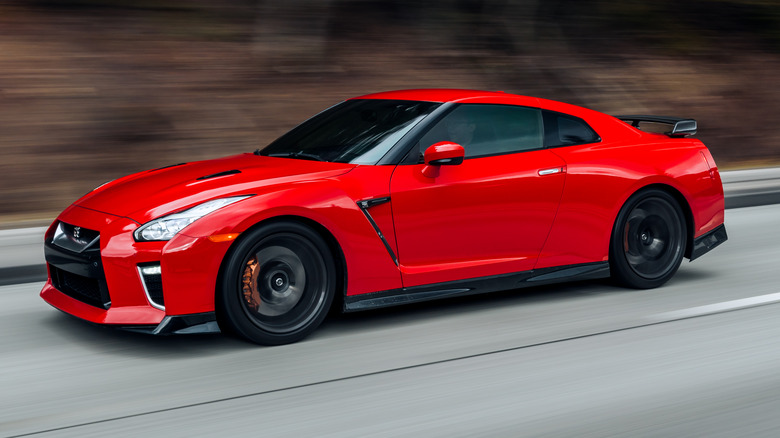
Brandon Woyshnis/Getty Images
The Nissan GT-R isn’t just a high-performance sports car; it’s an icon. Evolving from the 1957 Skyline by Prince Motor Company, the GT-R nameplate boasts a rich, six-decade history. In 2008, Nissan took the wraps off its current R35 generation, ditching the Skyline moniker and unleashing a twin-turbocharged V6 under its hood. These changes made the GT-R a formidable competitor to Italian and German supercars.
Despite its near two-decade tenure, the R35 GT-R’s popularity continues to surge. With a starting price of $121,090, it sits comfortably alongside rivals like the Chevrolet Corvette Z06, Porsche 911 Turbo, and Mercedes-AMG GT. But the GT-R’s secret weapon lies beneath the hood: a 3.8-liter twin-turbocharged V6, producing 565 hp and 467 lb-ft of torque. Nissan pairs the V6 with a six-speed dual-clutch automatic, powering all four wheels through its legendary ATTESA ET-S all-wheel drive system.
Developed in the late 1980s, Nissan’s ATTESA pioneered four-wheel anti-skid and torque split control to boost braking performance significantly. Today’s iteration continues that legacy, seamlessly varying front-to-rear torque for optimal performance in any situation. Nissan further refines the GR-R with a meticulously tuned suspension to offer three driver-selectable modes: Normal, Comfort, and R. This translates into newfound confidence behind the wheel, making the GT-R a surprisingly capable winter sports car, Unlike much of its garage-bound brethren. This is one of the few sports cars that truly thrives year-round (with well-rated snow tires, of course).
Porsche 911
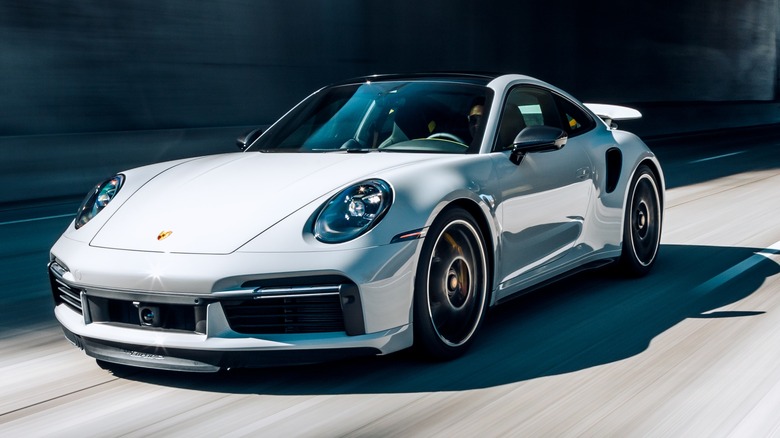
Brandon Woyshnis/Shutterstock
Six decades of evolution haven’t dulled the Porsche 911’s edge. Debuting in 1963 at the Frankfurt Motor Show as the 901, this legendary sports car has transcended generations, continually pushing the boundaries of performance and sports car design. Even in its eighth generation, the 911 retains the emotive spirit and raw power of its predecessors.
The soul of the 911 lies in its signature rear-mounted horizontally opposed six-cylinder engine. This placement lowers the center of gravity, contributing to the 911’s exceptional handling. Some models even leverage turbocharging, giving Porsche a spectrum of 911s, from the base Carrera to the track-focused GT3 RS. Base Carrera models pack a 3.0-liter turbocharged unit with a thrilling 0 to 60 mph sprint of 3.9 seconds and a top track speed of 183 mph. That’s all while paired with a smooth-shifting eight-speed PDK automatic transmission powering the rear wheels.
For enhanced grip and all-weather capability, Porsche offers all-wheel drive variants incorporating the ingenious Porsche Traction Management (PTM) system, which actively distributes torque between the front and rear axles. PTM constantly analyzes driving conditions, preempting and adapting to any situation. This, combined with faster-reacting dampers and rear-axle steering in trims like the 911 Carrera 4 GTS and Turbo S, translates to a predictably sharper 911 with unwavering driver confidence.
Rimac Nevera
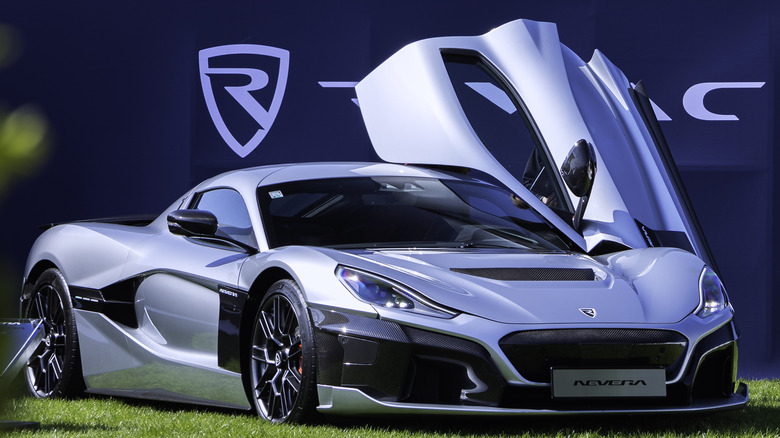
Martyn Lucy/Getty Images
Unveiled in 2018 at the Geneva Motor Show as the C-Two concept, the Rimac Nevera transformed from a design study into a storm of its own name, embodying Rimac’s form-follows-function philosophy. Named after a quick, mighty, and unexpected Mediterranean storm, the Nevera unleashes a torrent of electric power. With 1,914 hp and 1,741 lb-ft of torque, it triples the performance of ICE-powered sports cars like the Porsche 911 Turbo S, Chevrolet Corvette Z06, and Nissan GT-R. That’s thanks to a quartet of permanent magnet motors getting power from a liquid-cooled 120 kWh battery pack.
Rimac’s use of your surface-mounted motors equips the Nevera with not just all-wheel drive but a sophisticated All-Wheel Torque Vectoring (AWTV) system, which replaces the traditional traction and stability control systems. This system gives the Nevera infinitely variable dynamic responses on the road and track. It calibrates the precise amount of torque distributed to each wheel, delivering exceptional agility and ultimate stability. Coupled with components like the double wishbone suspension, the system facilitates any driving style through the seven selectable driving modes.
In our experience, driving the Nevera felt almost too fast, with the sprint from 0 to 60 mph taking just 1.74 seconds, and crossing a quarter mile taking just 8.25 seconds. Playing with the steering, power delivery, brake, and shock damper modes on the fly effectively smoothes out road imperfections, allowing the Nevera to carve canyons with precision. For more exhilaration, the Nevera has a fully rear wheel drive drift mode, for letting loose the inner hooligan. These qualities make the Rimac Nevera a true all-rounder that can thrive in various environments, including city commutes, highway cruising, and track days.